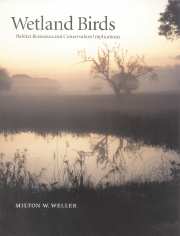Book contents
- Frontmatter
- Contents
- List of plates
- Preface
- Acknowledgments
- 1 Introduction
- 2 Wetlands: what, where, and why
- 3 Major groups of birds that use wetlands
- 4 Water and other resource influences
- 5 Foods, feeding tactics, strategies, and guilds
- 6 Bird mobility and wetland predictability
- 7 Other behavioral and physical influences on wetland living
- 8 Spatial and structural patterns
- 9 Habitat dynamics: water, plant succession, and time
- 10 Population consequences of wetland abundance and quality
- 11 How birds influence wetlands
- 12 Conservation implications
- 13 Measures of bird habitat use and quality
- 14 Current status and some conservation problems
- 15 Conservation and management strategies
- 16 Outlook
- 17 Epilogue
- Appendix 1 Scientific names of birds and bird groups
- Appendix 2 Scientific names of animals and animal groups other than birds
- Appendix 3 Scientific names of plants and plant groups
- Index of birds and bird groups
- Subject index
3 - Major groups of birds that use wetlands
Published online by Cambridge University Press: 02 October 2009
- Frontmatter
- Contents
- List of plates
- Preface
- Acknowledgments
- 1 Introduction
- 2 Wetlands: what, where, and why
- 3 Major groups of birds that use wetlands
- 4 Water and other resource influences
- 5 Foods, feeding tactics, strategies, and guilds
- 6 Bird mobility and wetland predictability
- 7 Other behavioral and physical influences on wetland living
- 8 Spatial and structural patterns
- 9 Habitat dynamics: water, plant succession, and time
- 10 Population consequences of wetland abundance and quality
- 11 How birds influence wetlands
- 12 Conservation implications
- 13 Measures of bird habitat use and quality
- 14 Current status and some conservation problems
- 15 Conservation and management strategies
- 16 Outlook
- 17 Epilogue
- Appendix 1 Scientific names of birds and bird groups
- Appendix 2 Scientific names of animals and animal groups other than birds
- Appendix 3 Scientific names of plants and plant groups
- Index of birds and bird groups
- Subject index
Summary
Many books have been written about the taxonomic groups of birds that frequent shallow water or the water's edge, and readers who do not know these birds should use a field guide in conjunction with this text. However, to help the nonspecialist, I have tried to list the major groups worldwide that are obligate waterbirds and I have included other orders less dedicated to water but with examples of wetland representatives (Table 3.1). To appreciate this diversity, it may be helpful to provide a framework for bird distribution at various scales.
Distribution and adaptations
Bird distribution often is discussed and compared from a geographic perspective (zoogeography). At one time, emphasis was mostly on a scale of continents and hemispheres rather than regional habitat, but the importance of vegetation zonation and climate has now become a regular factor in descriptions of groups and subgroups of species. At a somewhat smaller scale, identifying where a particular species is found using geographic and large-scale biotic zones is valuable. This is known as the geographic range, which may include geographically separated areas for breeding, wintering, or other needs. A more functional descriptor is home range, which denotes an area and habitat features that delimit the living space of an individual, pair, or other specified group. All of the area in which an individual, species, or taxon may be seen (i.e. distribution) is not necessarily habitat (i.e., the area used by the bird), as the bird may pass through less-than-suitable areas to locate the suitable ones.
There is a wide range of adaptation to wetlands among species of any of these taxa.
- Type
- Chapter
- Information
- Wetland BirdsHabitat Resources and Conservation Implications, pp. 23 - 48Publisher: Cambridge University PressPrint publication year: 1999



